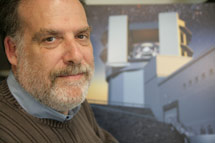
Handy Links
SLAC News Center
SLAC Today
- Subscribe
- Archives: Feb 2006-May 20, 2011
- Archives: May 23, 2011 and later
- Submit Feedback or Story Ideas
- About SLAC Today
SLAC News
Lab News
- Interactions
- Lightsources.org
- ILC NewsLine
- Int'l Science Grid This Week
- Fermilab Today
- Berkeley Lab News
- @brookhaven TODAY
- DOE Pulse
- CERN Courier
- DESY inForm
- US / LHC
SLAC Links
- Emergency
- Safety
- Policy Repository
- Site Entry Form

- Site Maps
- M & O Review
- Computing Status & Calendar
- SLAC Colloquium
- SLACspeak
- SLACspace
- SLAC Logo
- Café Menu
- Flea Market
- Web E-mail
- Marguerite Shuttle
- Discount Commuter Passes
-
Award Reporting Form
- SPIRES
- SciDoc
- Activity Groups
- Library
Stanford
Around the Bay
People: Solving Puzzles with Steve Kahn
Experimental cosmologist Steve Kahn loves wrestling with the snarls and tangles of a good conundrum—even when he's off the clock.
"I'm an avid fanatic of crossword puzzles," Kahn said, "particularly the hard ones." In the well-known sequence of the New York Times crosswords, he prefers Fridays and Saturdays, puzzles not for the faint of heart.
"What makes them hard is that the clues aren't constraining; they don't uniquely point to an answer," Kahn said. "So you have to keep all these possibilities in your mind at the same time, and find a way that it kind of locks in and shows you the potential answers are correct."
Problems of the most diabolical and vexing sort delight Kahn's scientific palate as well. He even admits to overlooking a question with a potentially more interesting answer for another one that promises more noggin scratching and hair pulling.
"This is overly simplistic, but there are sort of two kinds of scientists," he explained. "One kind is mostly interested in the answers, and the other is more interested in the process. I'm more in the process category."
In June, Kahn, who is currently associate lab director of SLAC Particle Physics and Astronomy, will change roles to delve deeper into a scientific project that's full of rewards for both answer-hunters and problem-lovers. Kahn is the physicist in charge of building the world's biggest digital camera—boasting a whopping 3200 megapixels—for the Large Synoptic Survey Telescope, or LSST. Slated to come online in 2015 and begin operations in 2016, the LSST will take a full image of the entire visible-wavelength sky over the course of a few days. It will look deep into the universe for ten years, providing an extraordinary visual record of the evolving universe.
"We call it cosmic cinematography. We'll measure everything that's changing everywhere in the universe," Kahn said.
The LSST will help scientists tackle a slew of mysteries. One of them—Kahn's interest—is dark energy, the mysterious energy field which scientists believe is causing the universe to expand faster and faster. Dark energy is closely intertwined with dark matter, the material that neither emits nor reflects light of any wavelength, yet is five times more abundant in the universe than visible matter—meaning its gravitational pull formed the galaxies. Mapping dark matter concentrations could untangle the tantalizing enigma of dark energy, but the stuff is devilishly difficult to study, except through an effect called weak gravitational lensing.
Because dark matter has mass, light from a distant galaxy bends as it passes dark matter on its way to Earth. By looking at how the image of the galaxy is distorted, scientists should be able to deduce the properties of the intervening dark matter clump—except that there's no way of knowing how the galaxy looked in the first place. So researchers compare the distortion in two nearby galaxies whose light passes through the same dark matter clump. But this tenuous signal is threatened by noise from any number of factors—the distortions within the telescope, the interference from the atmosphere, the fact that galaxies aren't perfectly round.
"The problem is that the measurement is extremely difficult, because the characteristic distortion that we're looking for is like one part in ten thousand at the lowest levels," Kahn said. "You have to look at huge numbers of galaxies in order to average all that away. So with LSST we look at about 3 billion galaxies, and measure the correlations between all of them. With the map of the concentrations of dark matter as a function of cosmic time, we can infer the details of the cosmic expansion history. This in turn provides the constraints on dark energy that we are really after.”
As the lead physicist for the LSST camera, Kahn's plate is heaped with perplexing tasks, including aligning the camera's multitudinous sensors, or reading out and storing and working with a data set that's comparable in size to all of the world's existing information. At the same time, he finds studying dark energy fascinating—less because dark energy is such a mystery than because that mystery is potentially solvable, like a crossword puzzle.
"The really astounding thing is not, 'okay we discovered something and don't know what it is.' That happens all the time," Kahn said. "The really astounding thing is that all these things fit together so well in this really amazingly simple model. But the model has at its core completely unknown physics that's not compatible with anything else that is currently known. There has to be some underlying, deeper reason why these things work so well."
—Lauren Schenkman
SLAC Today, April 22, 2009
